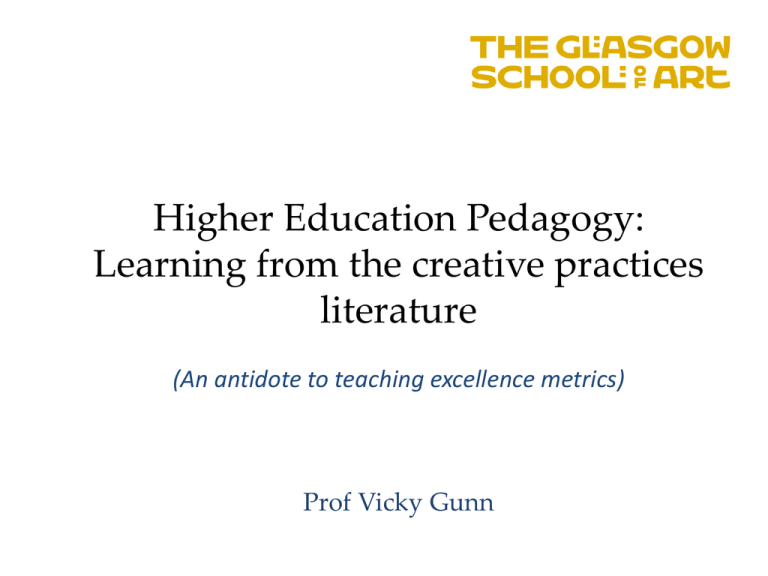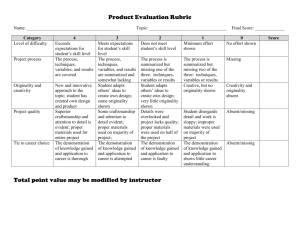Powerpoint slides
advertisement

Higher Education Pedagogy: Learning from the creative practices literature (An antidote to teaching excellence metrics) Prof Vicky Gunn Production line: Not a good metaphor for learning http://www.lucentvisions.com/gallery/images/Idea%20Machine.jpg What are your pedagogy research passions? How do we foster deep learning in our disciplines? Collaborative learning in & beyond the university Role of technologies? Reflective praxis? Resilience in /through diversity? The Question behind our teaching passions How do we improve student learning? Where we’ve tended to look for answers to the question • Cognitive psychology • Sociology Phenomenography (Disembodied phenomenology) Common research-informed foci Quality of interaction with peers and staff Orientation to study and learning approaches Self-efficacy and resilience Ability to adapt, translate, transform knowledge from one context to another Intellectual development and information processing Dominant ‘proxy’ for pedagogic effectiveness Using teaching methods which support sufficiency of understanding in the disciplinary context to cultivate simultaneously: • immediate subject area predetermined outcomes • career-wide approaches to learning Dominant judgement of best ‘way of thinking’ at disciplinary level Creativity and originality within the parameters of the given discipline Sociological expression of disciplinary originality Emergence of innovation in disciplines dependent on three elements: • A culture that contains symbolic rules • A person who brings novelty to the symbolic domain • A field of experts who recognize and validate the innovation Csikszentmihalyi, 1997, p.6 Disciplinary creativity and originality • Materialization of people’s passions as excitatory charge of disciplines • The social commodity of what academics do • Anticipatory temptation for some of our students Three threads • There’s more to teaching than is currently supplied by our research on it • Disciplinary creativity and originality can be a focus of teaching • Increasingly unbalanced weight given to particular types of thinking over doing & making in undergraduate programmes Different conceptualisations of originality and creativity in the disciplines Artist Designer Maker Maker / Artist “Innovation requires thinking and doing at the same time about things we haven’t imagined yet.” Sharma, 2013, p. 242 Activity in the space of the unthought, the ‘not theory’ (Borgdorff, 2012); Ludic experimentalism & singularity Designer “Creativity might be better understood as a process and a feeling.” Gauntlett, 2011, p. 7 “The design process thus can be viewed as a creative means for designing a new reality.” ….with the outcome being both novel and appropriately useful Chang et al, 2015, p. 372 NB Creativity in Art & Design not the same within or across these areas Foresight of a maker – “lies not in the cogitation that literally comes before sight but in the very activity of seeing forward, not in preconception but in anticipation” Ingold, 2013, p. 69; Sennett, 2008, p. 175 And my point? Each of these conceptualizations is made active through teaching regimes in Art Schools And students materialize meaningmaking in these regimes Dimensions & realms of learning via Studio Realms: Reasoning (logic) Sensing (aesthetics & affect) Playing & connecting (method) Reasoning http://www.creativitypost.com/images/made/images/uploads/science/iStock_ 000019723630Small_610_300_s_c1_center_center.jpg Genesis of Creativity as part of a ‘method’ in Art & Design? Pre-discursive Practices Inductive (Borgdorff, 2012) Deductive Abductive ‘speculative pragmatism’ (Manning & Massum, 2014; Sharma, 2013) So what? • Pre-configured • Configuring How much of our teaching supports student engagement with these? • Configured expression of physical, material, ideas as well as evaluation within a cultural context Feeling like this yet? Problem of Constructive Alignment and Phenomenography • Both start at inductive part of the method • Focus student learning on identifying appropriate salience almost exclusively (Entwistle, 2005, p. 4) • Doesn’t tell us about what fosters creativity either in disciplinary terms or Art & Design terms Sensing, Aesthetics & Affect Missing in the HE literature on teaching: • What leans us towards or away from objects of study? How does this relate to what we discern and feel and, from them, teach? • How does this change the way we making sense of our students’ learning? • How do the spaces, objects, and immaterial in which our teaching occurs influence how we teach? Playing, experimenting, connecting • Genesis point of originality in the disciplines • Embodied as well as cerebral • Encourages links of the seemingly irrelevant to the topics of the discipline Implications for curriculum: Our brief • Curriculum Mapping for reasoning, aesthetics, & playful experimentation • Creating progressive, assessable opportunities for pre-discursive & abductive reasoning • Disorienting student expectations by disrupting typical teaching approaches • Encouraging meaning-making as revelation through making Why bother? • Fuelling originality in the disciplines • Revitalizing disciplinary content and methods • Challenging students’ intellectual instrumentalism • Supporting development of creative agency • Fighting back against metricization of teaching excellence….



